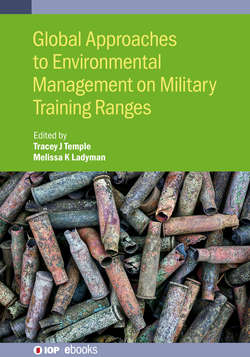Читать книгу Global Approaches to Environmental Management on Military Training Ranges - Tracey Temple - Страница 22
На сайте Литреса книга снята с продажи.
Rate of dissolution
ОглавлениеThe primary mechanism by which explosives migrate into the environment is by dissolution during precipitation [21]. However, only a limited number of methods are available to determine the dissolution rate of explosives in the environment often using different experimental approaches, making the direct comparison of results difficult. For example, methods used in the pharmaceutical industry, where dissolution rates are determined by introducing a solid to a large volume of agitated water and then measuring the time taken to achieve dissolution by sub-sampling at frequent intervals have been used to investigate the effect of variable temperatures (10 °C, 20 °C and 30 °C) on the dissolution rate of RDX and TNT [21]. However, explosives in the environment are unlikely to be submerged continually in agitated water, and are more likely to be dissolved through the action of sporadic rainfall. Further studies to determine changes to the three-dimensional structure of explosive formulations during dissolution by precipitation have been undertaken by submerging samples in water without agitation [89]. The samples were submerged in deionised water (DI), which is not representative of natural rainfall because the pH of the water is controlled (pH 7) and submerging the sample does not simulate the mechanical action of rainfall. This approach allowed the samples to be imaged by digital microscopy, which measured the dimensions of the samples as they dissolved.
To simulate the mechanical action of rainfall, indoor dripping tests have been carried out using glass frits holding pieces of explosive underneath the simulated water flow [76]. Water can be delivered using a gravity-fed system [79], or by rate-controlled systems such as peristaltic or syringe pumps [38, 90, 91]. The dripping is designed to mimic rainfall, although the rate of delivery is averaged against real weather conditions, e.g. to a consistent time and droplet size. However, artificial droplets are generally larger than natural rain falling at the same rate, highlighting the difficulties of simulating rainfall precisely [37]. Indoor rainfall simulations may be continuous or may include pauses for drying time, which increases the mechanical stress on the sample and is more representative of natural weather [90]. For example, drying the sample introduces cracks that allow the ingress of water, and may increase the rate of dissolution, but it is difficult to isolate and measure the effect of this variable in the laboratory. In addition, these indoor experiments only investigate the relationship between rainfall and dissolution, and do not consider other environmental variables such as temperature and sunlight. To account for all variables, similar experiments have been undertaken outside and have shown similar dissolution rates, but significant differences were observed in the mass of explosive recovered [90, 92]. This suggests that the dissolution rate may be largely dependent on water volume, but the explosives may be degraded through other mechanisms such as photodegradation when on the soil surface, which cannot be determined by laboratory-based dripping experiments.
